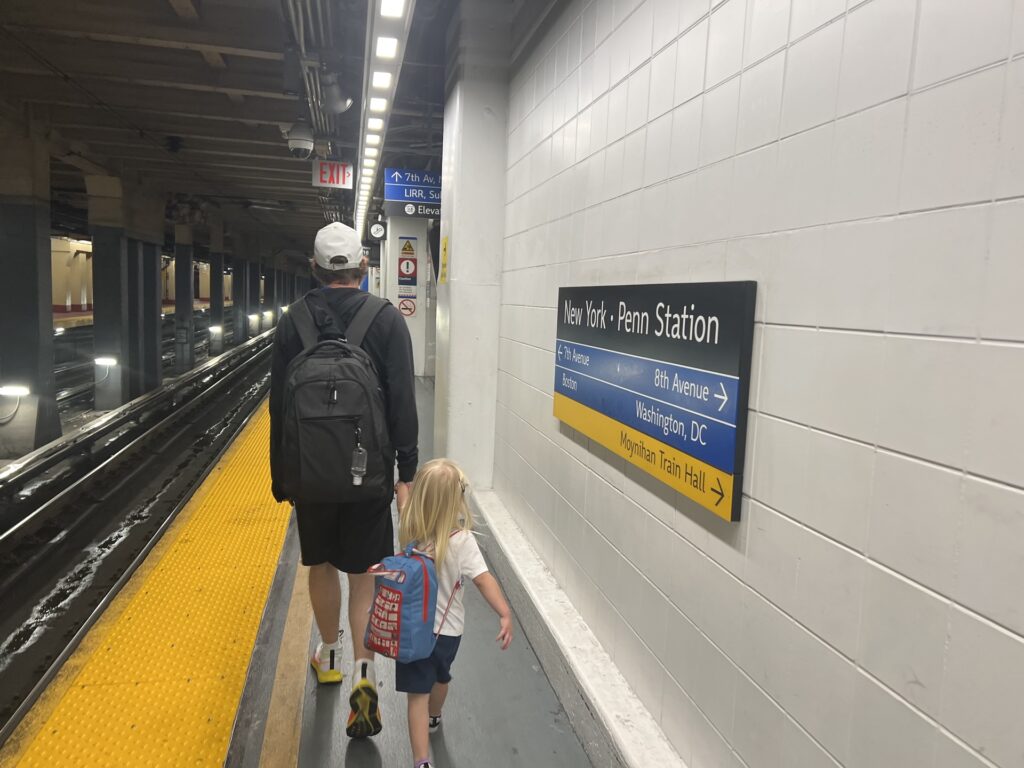Philadelphia is a popular weekend trip from New York City. The fellow former US capital city is packed with history, sports, and a certain bell that you’ve probably heard of. And since it’s only about 100 miles south of NYC, it’s quick and easy to get to. One way to get to Philadelphia from New York City is by train.
In this post, we explain how to take the Amtrak train from NYC to Philadelphia and back again. We’ll start with some general information about Amtrak and this route, and then we’ll go into our personal experience taking the Northeast Regional and Keystone Service trains between these two cities.
If you’re wondering what it’s like to take the Amtrak train from NYC to Philly and back, keep reading!
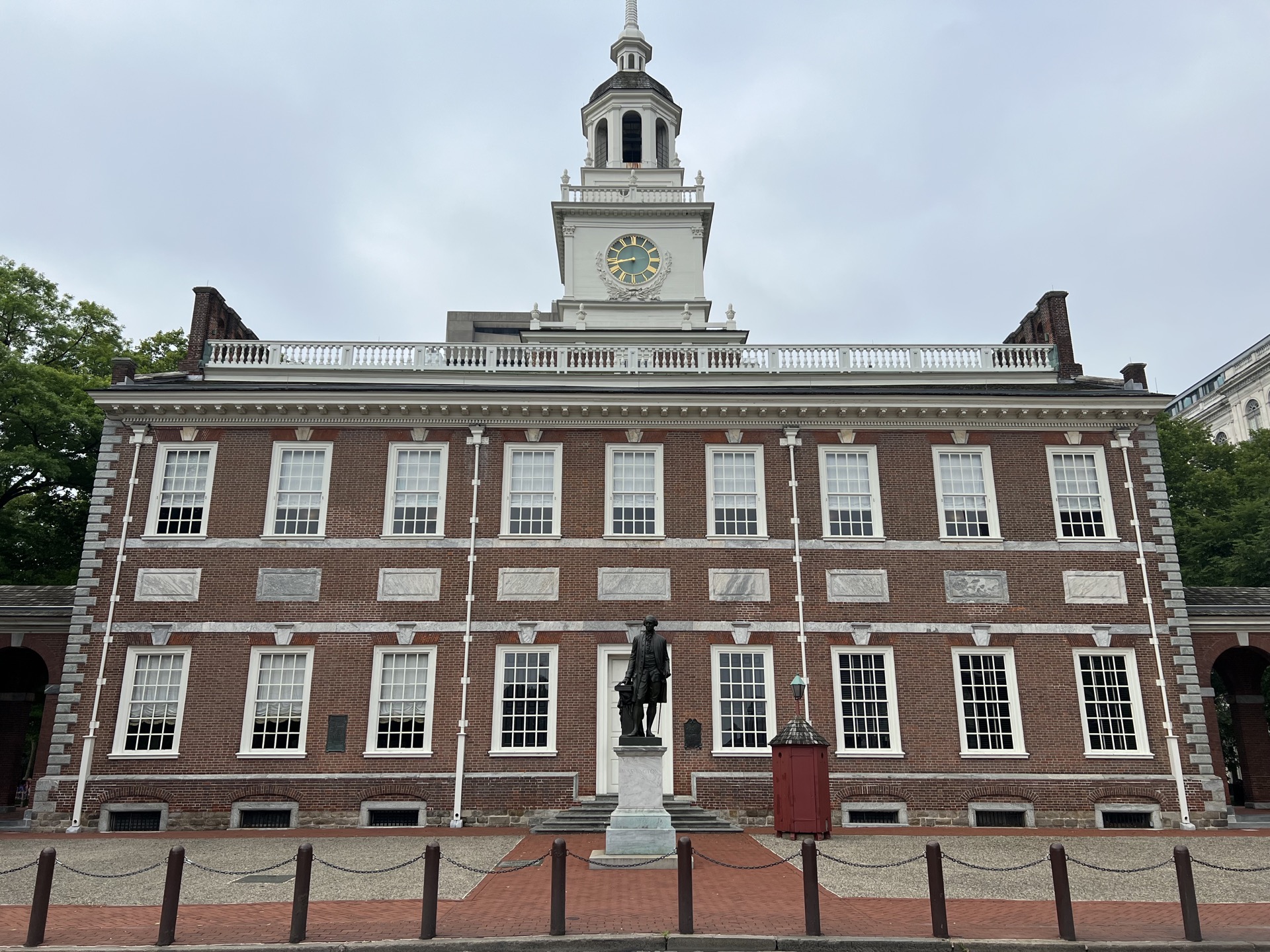
How to get from NYC to Philadelphia
There are a few different ways to get from NYC to Philadelphia.
One option is to drive. This of course requires that you have a car, or are willing to rent one. (The cost of renting a car is pretty quickly going to make it a pretty expensive option, though.) Travel times vary based on the time of day, but at the moment Google Maps thinks that trip is going to take at least 2 hours by car. That does not include the time it takes to find parking, stop for gas, and actually get trough the suspected traffic.
The price is tricky to calculate, but if your car gets about 50 mpg and gas is $5/gallon, it’s going to be at least $20 in gas money. You’ll also need to factor in parking fees in Philadelphia, which are not always complimentary with your hotel booking. For example, we stayed at the Independence Park Hotel and parking was $23 per night. As a rough estimate, let’s say it costs about $75 to drive for a weekend trip.
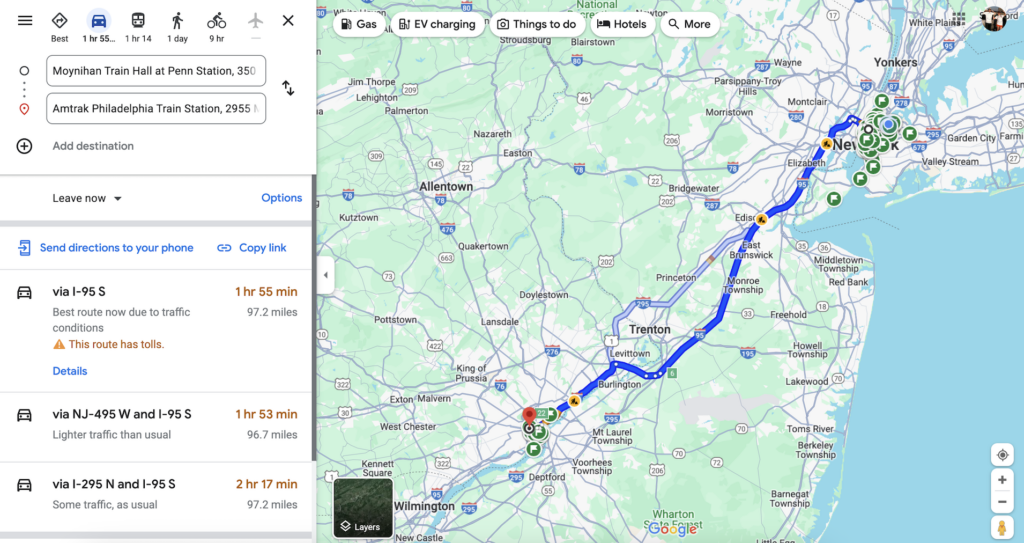
Another option is to take the train. Depending on the time of year, Amtrak operates at least 5 different daily routes between NYC and Philly (50+ departures a day) and they all take less than 90 minutes. Of course, that’s generous and you still need to factor in the time it takes to get to and from the train station in both cities, plus a little bit of train station buffer time. (For example, our total travel time from our apartment door in NYC to our hotel lobby in Philly was about 3.5 hours.)
The train prices vary based on how early you book, departure time, route, and seat class. If you book early and are willing to travel in the early morning or evening hours, a roundtrip train ticket can be as low as $20! However, if you wait till the last minute or want to travel in business or first class, tickets can be as much as $200 one way. As a reasonable example, we booked our tickets three months in advance. It cost $95 total for three roundtrip tickets (2 adults, 1 child) with midday travel times.
A final option is to fly, but I don’t think many people are actively considering that. Surprisingly, both Newark and LaGuardia have daily nonstop flights to Philadelphia. The flight itself is only an hour, but when you factor in airport time and commutes, it’s probably the slowest option. Plus, a ticket is going to set you back close to $400 roundtrip.
Another option that we don’t highly recommend is the bus. Travel providers including Flix Bus, Greyhound and Megabus all run buses between NYC and Philly. Tickets can be cheap, but they are very rarely cheaper than the cheapest train ticket, and the train is way faster.
So what’s the best way to get from NYC to Philly? The train. It’s usually the cheapest, fastest and most comfortable option.
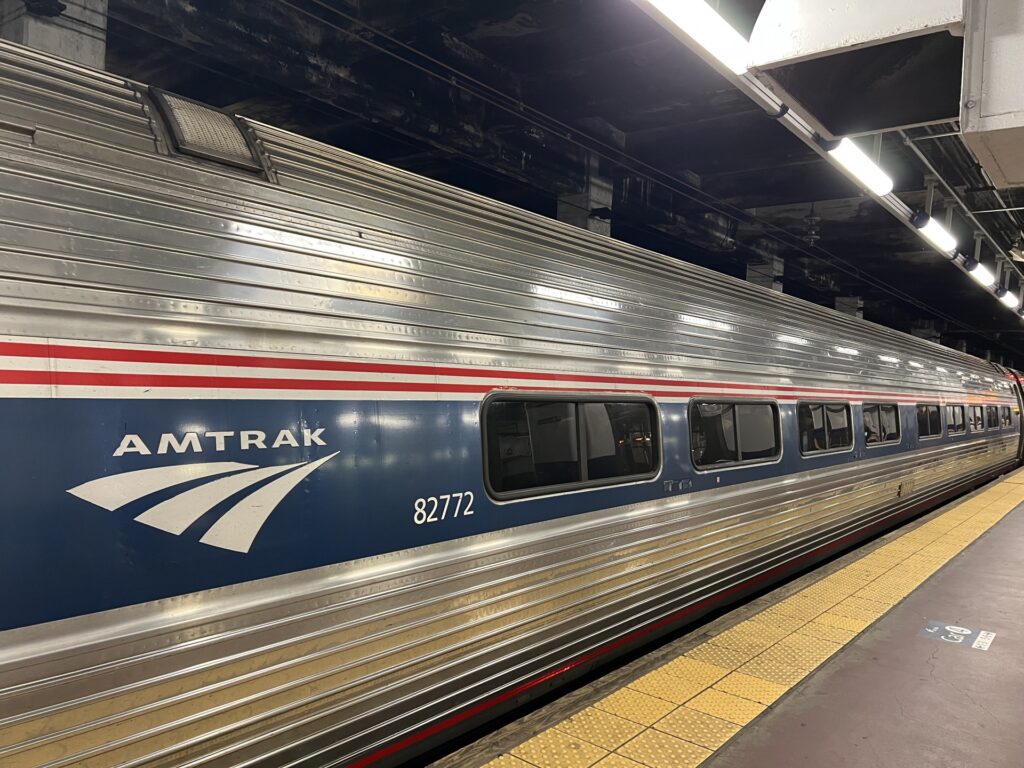
Amtrak Train Routes Between NYC and Philadelphia
The Northeastern Corridor — the railway system between Boston and DC — is the most heavily used and densely connected rail service in the entire US. More than 2,000 trains run throughout the region daily, connecting major cities along the way including New York City and Philadelphia.
At least five major Amtrak routes run between NYC and Philly, resulting in over 50 departures daily. While all of these routes look a little different on either side of these cities, the route in the middle is basically the same. Some routes make a few more stops than others, and some trains go a bit faster, but they tend to only differ by about 20 minutes of travel time.
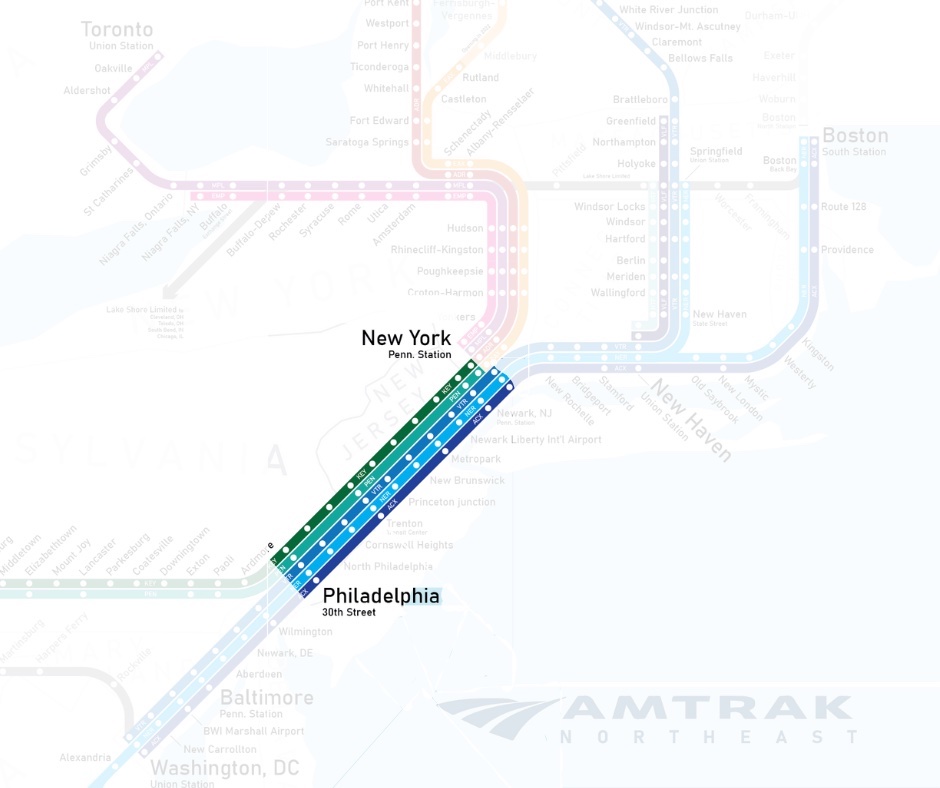
While the travel time is pretty similar on all the Amtrak routes between NYC and Philadelphia, the experience (and therefore price) can vary. For example, the Acela Line (which runs the full route from Boston to DC) is one of Amtrak’s nicest trains, and only has Business and First Class seats. It’s also the fastest train between these two cities, with a scheduled travel time of close to 1 hour 10 minutes.
In contrast, the Northeast Regional (which runs from Boston to Roanoke & Norfolk, Virginia) offers a much cheaper Coach option and a more expensive Business Class option. The Northeast Regional is scheduled to take a bit longer, because it makes a few more stops.
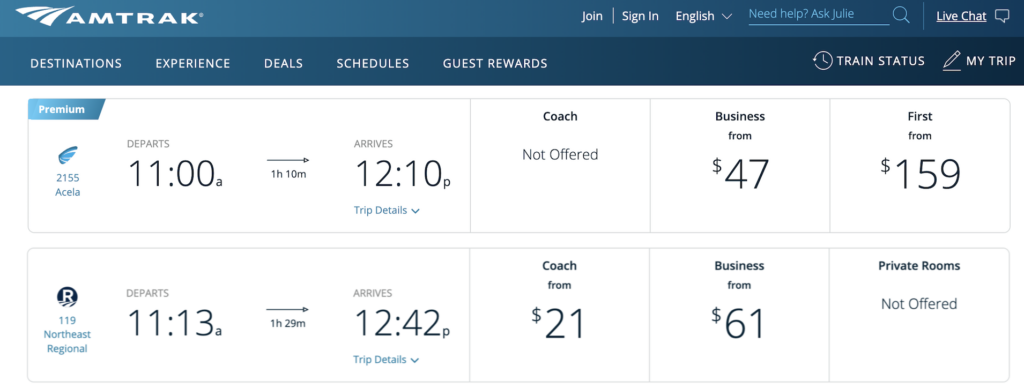
Other than the Acela though, the routes between these two cities are pretty similar. I’d focus on choosing the time that best fits your schedule and the class that best fits your budget and travel style.
In this post, we will be focusing on the Northeast Regional (NYC to Philly) and Keystone Service (Philly to NYC). If you’re interested in the Acela line, be sure to check out our review of taking the Amtrak from NYC to Boston. We rode both the Northeast Regional and the Acela on that trip, and offer a pretty detailed comparison in that post.
Amtrak Station in New York City — Moynihan Train Hall
No matter which route you choose, the Amtrak station stop in New York City is the same: Moynihan Train Hall at Penn Station.
Moynihan Train Hall serves Amtrak and Long Island Railroad. It is located right across from Penn Station, which serves NJ Transit. Moynihan Train Hall spans a full city block in Midtown Manhattan, between 8th and 9th avenues and 31st and 33rd streets. The station is easily accessible from a variety of subway stops and train stops, which we’ll mention in the next section.
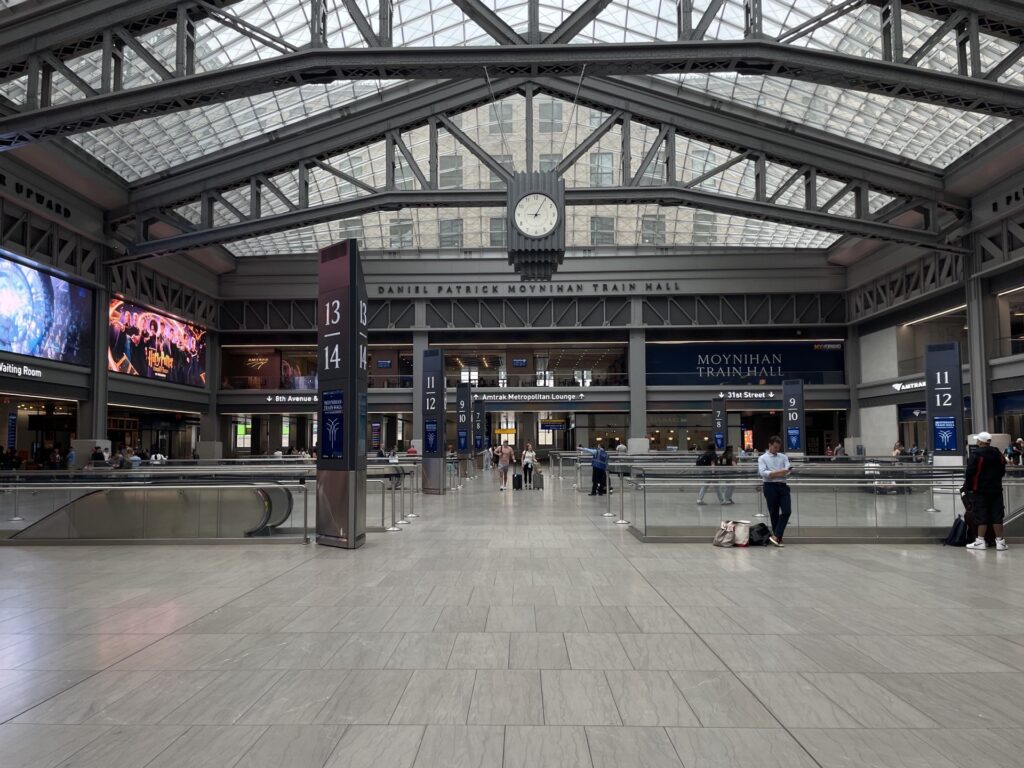
Moynihan Train Hall is a beautiful and functional new station that just opened in 2021. (Watch out European rail, we’re coming for you!) The majority of the station’s shops and services are located on the concourse level, including a large food court, several coffee shops and a newsstand. There is also a waiting area with plenty of seating for ticketed passengers only.
Just like at the airport, there are signs around the station that list all upcoming trains and their status. They do not announce the track number until shortly before boarding. Once the track is announced, passengers queue at the designed track number on concourse level. When boarding begins, passengers are led down to the platform, in order, to board the trains.
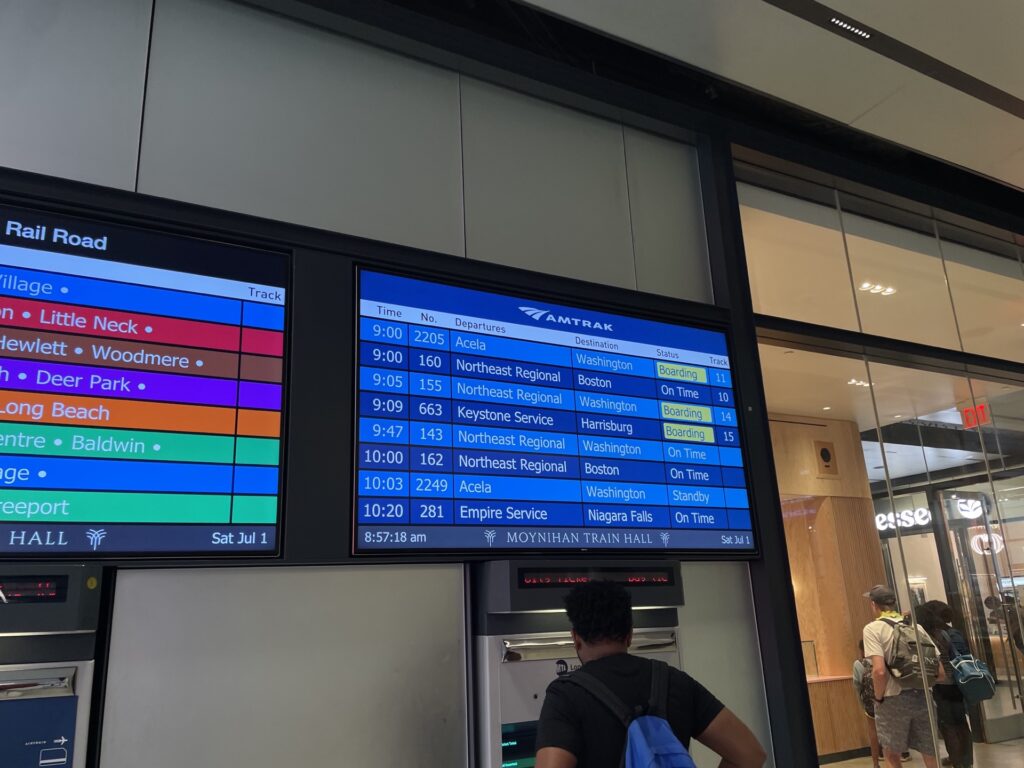
Getting to Moynihan Train Hall
You can get to Moynihan Train Hall at street level or via underground connections.
If you are approaching Moynihan Train Hall on foot or are planning to arrive via a rideshare or taxi service, the main entrance is on 31st Street mid-block between 8th and 9th Avenue. There are also entrances on all four sides of the building if you’re coming from a different direction.
Moynihan Train Hall is also easily accessible via subway. You can take the A, C or E trains to 34th Street Penn Station, which leads right to the train hall. You can also take the 1, 2 and 3 trains to 34th Street Penn Station, but that station is on the other side of Penn Station. If you get off here, you’ll need to walk through Penn Station underground or a block west on 33rd Street at street level.
At either subway station exit, follow signs toward Moynihan Train Hall.
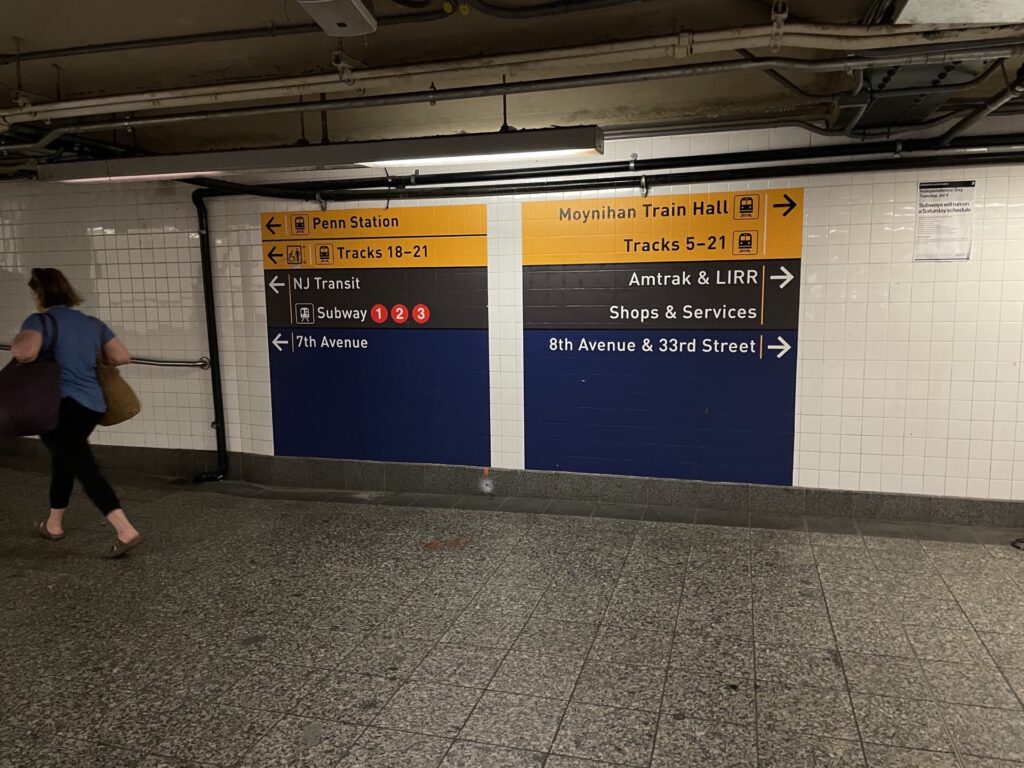
Amtrak Station in Philadelphia
There is only one Amtrak station in Philadelphia: William H. Gray III 30th Street Station. It’s located straight west of Center City, across the Schuylkill River.
It’s a nice, indoor station that is small enough to be easy to navigate, but big enough to warrant sufficient amenities. There’s lots of open seating, a decent food court, a few shops, and — my personal favorite — a Vibrant Coffee Roasters.
The Amtrak station is close to a SETPA station (Philadelphia’s subway system) on the Market-Frankford Line. It takes about 15 minutes to get from the station to Center City, depending on where you’re going. However, you could also take a rideshare, which in hindsight is probably what we’d recommend.
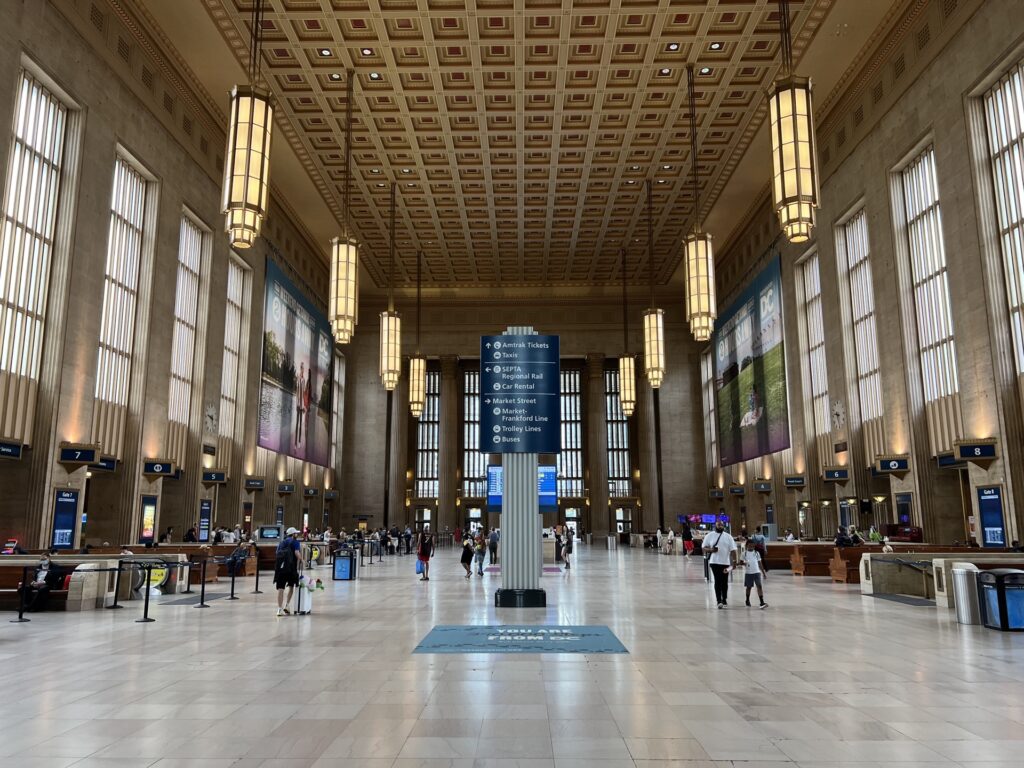
Buying Amtrak Tickets to Philly
You can buy Amtrak train tickets direct on their website. You can also see the full Amtrak route map and read more about each route here.
It’s not the best user experience, but it is pretty intuitive. Just like booking a flight, you can enter where you’re going and when, and then view the list of available trains and ticket types. In this list, you can clearly see the name of each route on the left side. There’s also flags that indicate things like the lowest fare and fastest route.
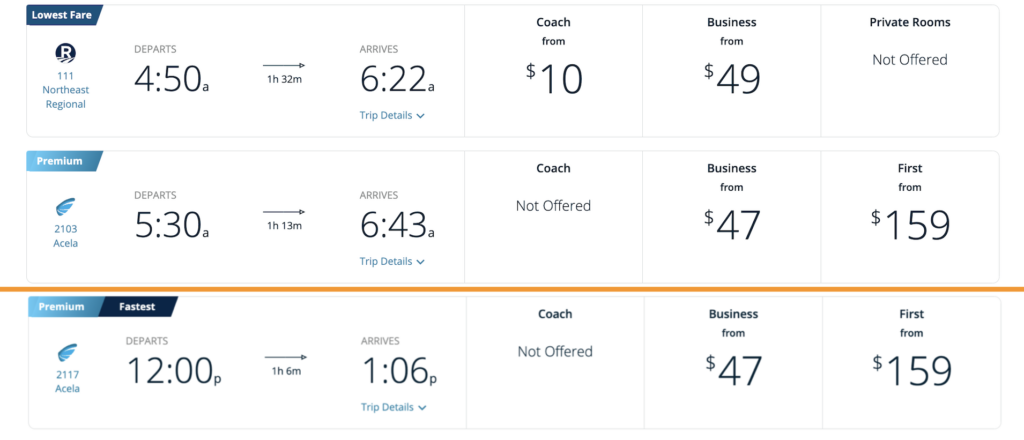
The most important thing to know about buying Amtrak tickets is that the price is fluid. Tickets get more expensive as the travel date approaches. They also get more expensive as tickets sell out, which is particularly noticeable around holidays. Popular travel times are also more expensive than early morning or late night times.
For the NYC to Philly route, the prices are most volatile on the Acela line and Business and First Class on other lines. These prices can easily vary by $50-$100 or more. Coach tickets on the slower and more economical Northeast Regional and Keystone Service trains tend to be pretty static, with variances closer to the $10-$20 range.
For the best deal, you should book early. However, if you can’t book early, you can usually still book. Other than a handful of popular routes and specific times leading up to holidays, entire Amtrak routes rarely sell out. There’s so many scheduled trains that run between NYC and Philadelphia, that you can almost guarantee a seat on one. It just might not be the exact time, class or price point you want.
A final note about booking and timing is seat selection. This is only relevant for the the Acela and Business Class on the Northeast Regional or Palmetto. (All coach class tickets on Amtrak are open seating, so seat selection is not an issue.)
If your train has assigned seats, you will automatically be assigned a seat when you book. After booking though, you can modify your seat selection to any available seat. For that reason, it can be advantageous to book early for the best seat selection. Seat selection isn’t too competitive though, as most of the seats are the exact same. Seat selection is mostly only important for parties of 3 or 4 who want to book a quad together, as quads can book up.
Whenever you buy your ticket, you will receive an email with your ticket attached. It has a QR code on it, and the conductor can scan it right from your mobile device. On Amtrak, they check your tickets at your seat shortly after the train departs each station.
Taking the Train from NYC to Philadelphia
In these next few sections, we’ll move on to our personal experience taking the Amtrak train from NYC to Philadelphia. We traveled Saturday to Tuesday over the Fourth of July holiday. Our NYC to Philadelphia leg was on the Northeast Regional and our return trip was on the Keystone Service. The total cost of our three roundtrip tickets was $95 (2 adults, 1 child). We paid in full, and this post is not at all sponsored or comped by Amtrak.
Boarding the train in NYC
We were booked on the Northeast Regional train #147, which was scheduled to depart Moynihan Train Hall at 9:47 AM. We arrived at the station just before 9 AM.
Amtrak recommends passengers arrive 30 minutes prior to their scheduled train’s departure. There is no security at Moynihan Train Hall, so you don’t need to budget time for that like you would on a plane. They also don’t announce the track until they start boarding, so there is no queuing advantage to arriving any earlier.
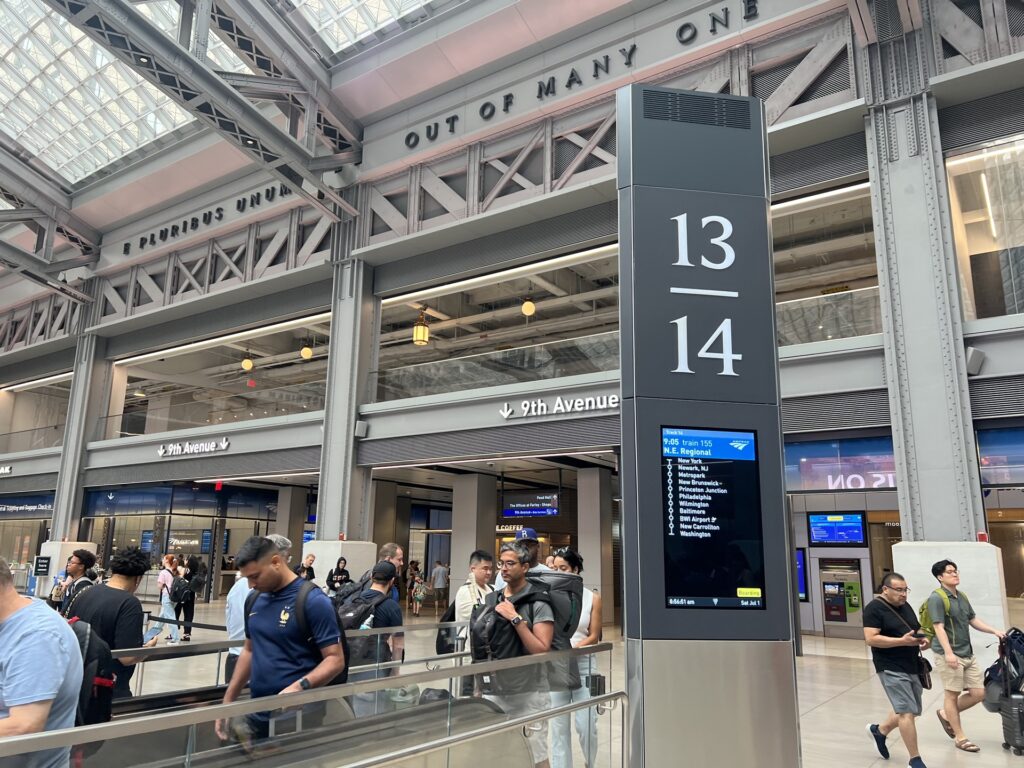
The only seating at Moynihan is a gated-off area for ticketed passengers only. We sat in this area a few weeks prior while waiting for our train to Boston, but we didn’t like it. It was filled with people all riding the same train. So when they announced the track, there was a huge mass of people trying to exit the area at the same time and get in line to board.
This time, we just stood in the main waiting area instead. That way, as soon as we saw our track number, we could quickly get to the front of the line. If you’re traveling with a group — in our case a family of 3 — the boarding order is important. In coach class, it is all open seating. If you board last, there’s a good chance you won’t find seats together.
If you’re traveling with young kids though, it’s worth checking with the agent at the front of the queue if they offer family boarding. We’ve taken several different Amtrak trains as a family, and it has never been consistent. Sometimes, we get a personal escort and board the train first, sometimes we’re placed in a priority boarding queue, and sometimes there is absolutely no benefit. It usually depends on the station, where you’re boarding on the train’s route and quite frankly, the agent’s mood.
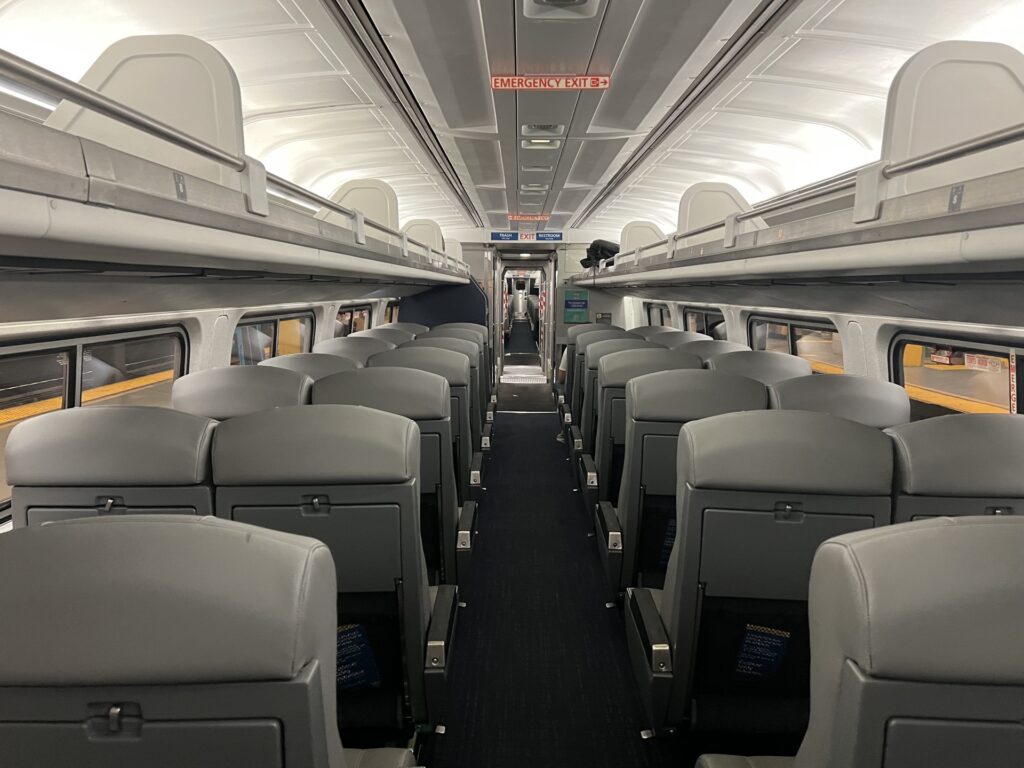
In this case, we were told to wait near the front of the line. That meant we got to board with the very first group. This was great because we were lead onto a completely empty car and had our choice of three seats together. (Well, two together and one across the aisle, which is as good as we can get.) By the time everyone had boarded, most of our train car was full.
The Northeast Regional train does not originate in NYC, so there will be passengers already onboard. However, they almost always reserve a handful of cars just for passengers boarding in New York. This means that if you’re near the front of the line, you’ll have no problem finding seats together.
The conductors will point you to which cars to board, but it is usually any car with open doors. All of the Coach cars are the same, so you can sit wherever you find space. The only exception to that is the Quiet Car. On the Northeast Regional, this is the car immediately adjacent to Business Class. They enforce a “library-like” volume, so no talking or cell phones. With a toddler, we always avoid the Quiet Car.
Riding Northeast Regional from NYC to Philly
We were seated in Coach on the Northeast Regional train. These trains are modern and comfortable, but not Amtrak’s nicest or newest product. That said, the seats are still wider and have more legroom than an Economy seat on an airplane, so it’s a pretty nice ride.
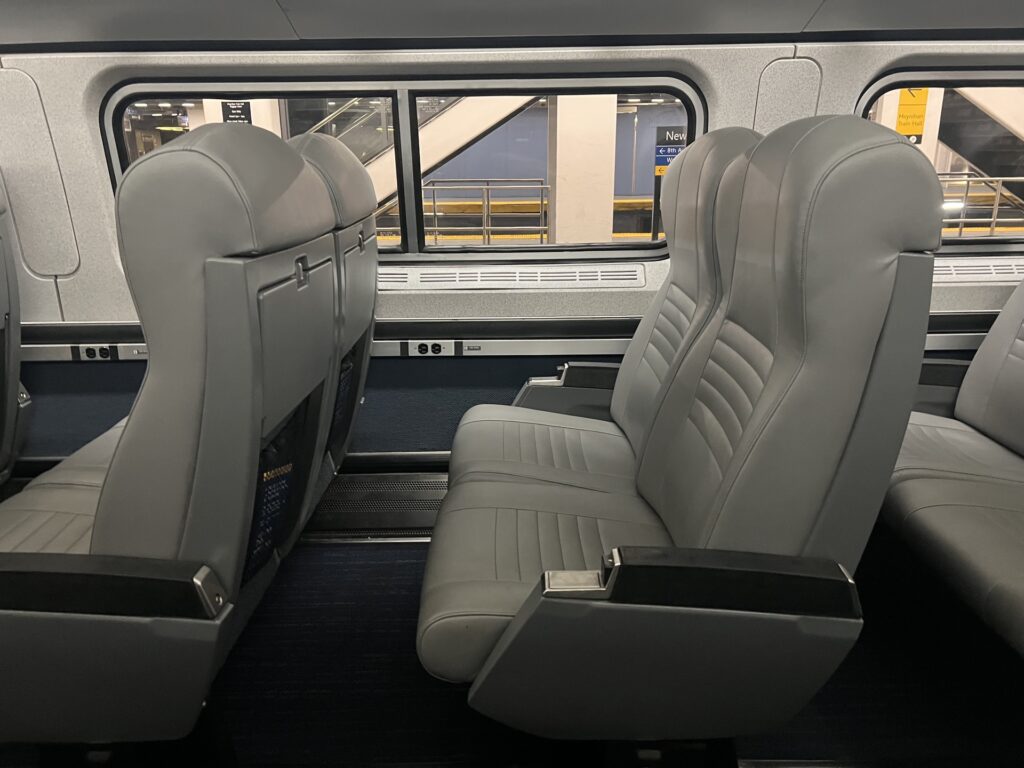
The seats are in a 2-2 configuration, with an aisle down the center. All of the seats on the Northeast Regional trains used to be forward facing, but that’s no longer the case. As of March 2024, the seats are now fixed with half facing forward and half facing backward. There are armrests along the aisle and window, but not between each pair of seats. Some trains have small, adjustable footrests, but this one did not.
On the back of each seat, there’s a small tray table that folds down. It’s big enough for a tablet or a drink, but we have frequently had problems with these tray tables not laying completely flat. There are also two outlets on the window side of each row of seats. This is great if you have a window seat or are traveling with a partner, but it can otherwise be a bit awkward to access for a solo aisle passenger.
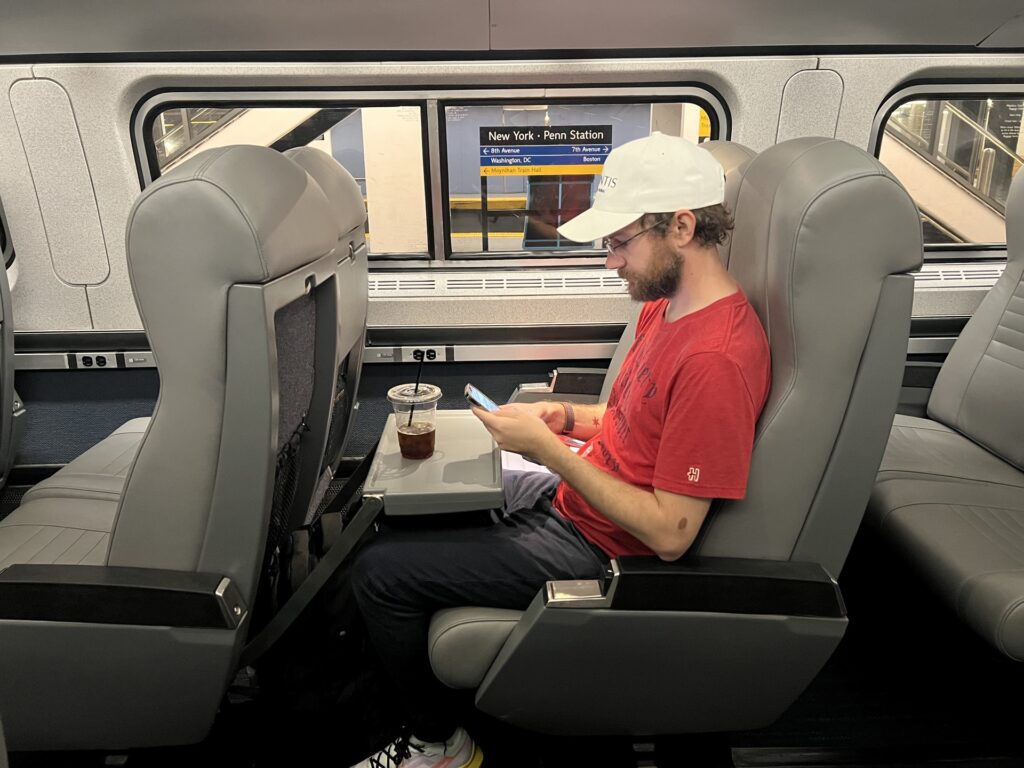
Amtrak has a pretty generous baggage policy. Every passenger (even in Coach) can bring a personal item and two bags (each weighing less than 50 lbs) for no extra fee. Baby items like diaper bags and strollers do not count against this baggage count. No only is it generous, but it’s typically pretty loosely enforced. I’ve only ever seen them actively checking and weighing bags one time, and that was on a code-share train to Niagara Falls in Canada.
There’s plenty of storage space on the train, too. You can store a personal item under the seat in front of you (up to a pretty large backpack), and then there’s overhead storage racks above the seats. Train passengers generally don’t bring as much luggage as airline passengers, so finding space is rarely an issue. If it is, there’s also luggage storage at the front and back of each car.
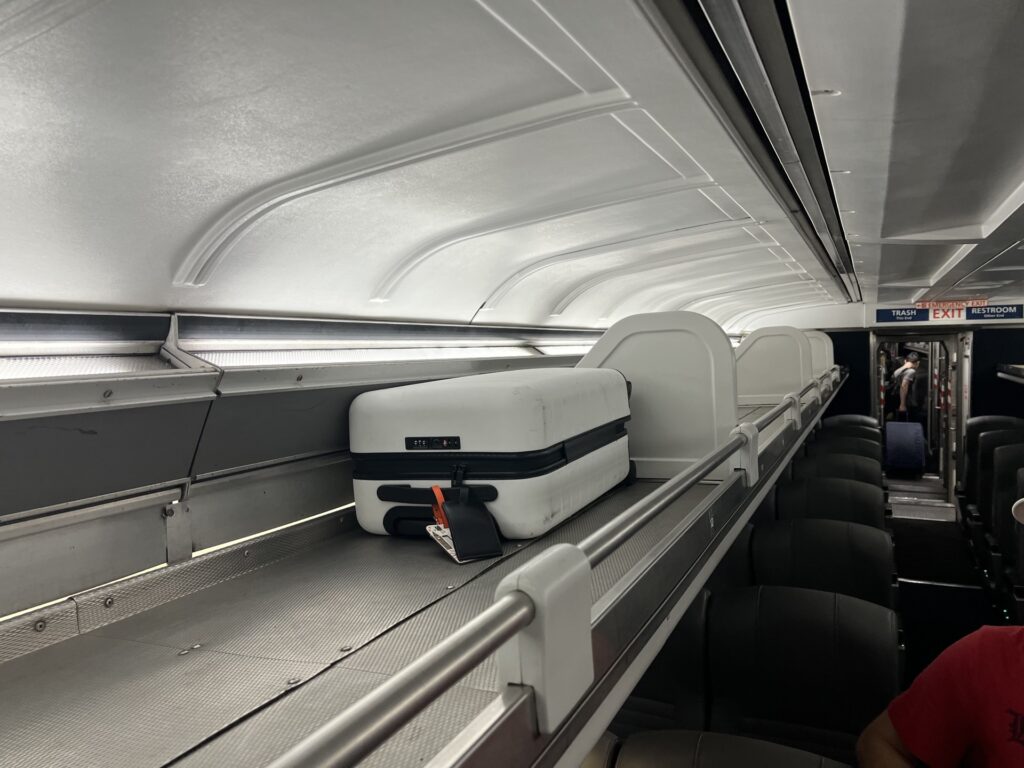
The Northeast Regional train has a cafe car that sells things like soft drinks, alcohol, snacks and hot meals. There are a few small tables in the cafe car, but you can also take food back to your seat. There is a bathroom located in the cafe car, as well as at the end of each individual car.
The Northeast Regional trains also have free wifi. It’s fine for things like social media and streaming, but it gets pretty slow if you’re trying to work on a laptop.
The journey from NYC to Philly went by pretty quick. It was scheduled for 1 hour 25 minutes, and we arrived right on time.
How to get from the Amtrak Station to Center City
We arrived in Philadelphia at the William H. Gray III 30th Street Station. The station is about a mile straight west of Center City, and about 2 miles from our hotel in the Old City area.
If it was just us, we probably would have walked it. However, we had a 2-year-old and a long no-nap day ahead of us (we were going straight from the hotel to the Phillies Game at Citizens Bank Park), so we didn’t want to wear them out unnecessarily.
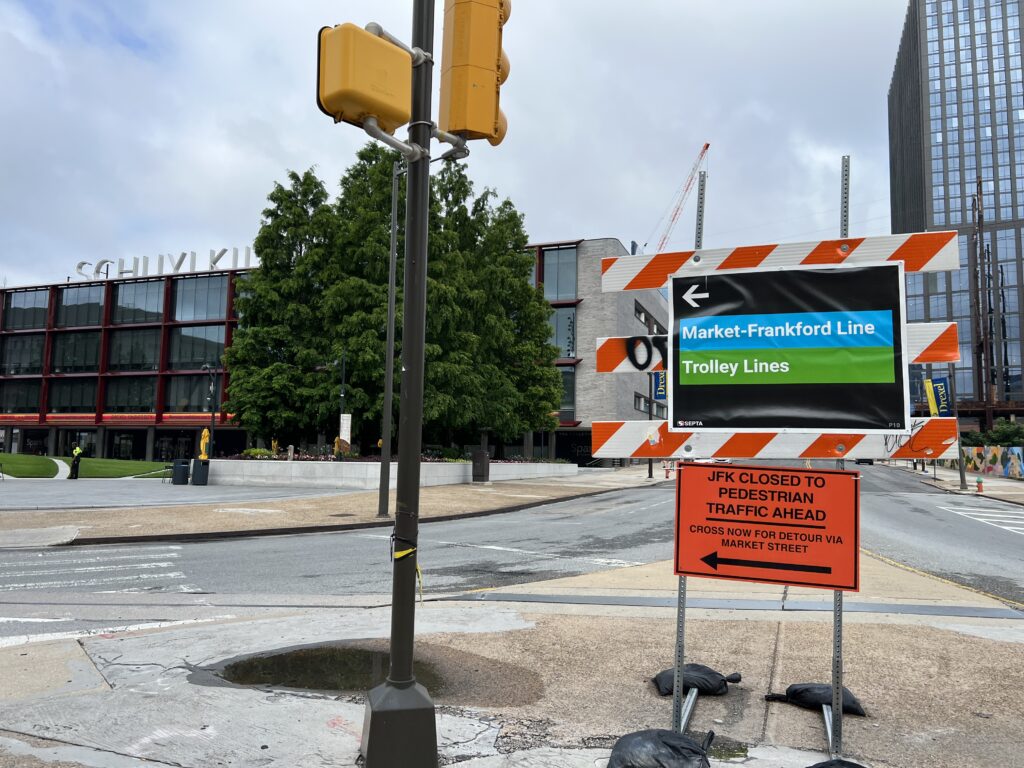
The best public transportation option from the station to Center City or the Old City is the metro train, which is called SEPTA in Philly. The Market–Frankford Line stops right across the street from the Amtrak Station, and runs east to 2nd Street near the water before turning north.
The SEPTA train in Philly wasn’t our favorite metro. The first point of frustration was that it didn’t have tap-to-pay entry. We had to stop at a kiosk to buy tickets each time, which was clunky. It also meant we missed the train that came right as we walked up, because we were buying tickets.
The actual train experience also left a bit to be desired. The metro isn’t as popular in Philly as it is in NYC, presumably because more people have cars. That left the trains feeling a bit empty, and with a different type of crowd. That also meant they didn’t run as often and weren’t as well maintained.
We are typically very pro public transportation, but we’d probably skip it next time. For $8 more ($4 for two adult fares on the train versus $12 for an Uber ride), door-to-door service and a faster commute, we’d recommend the rideshare route.
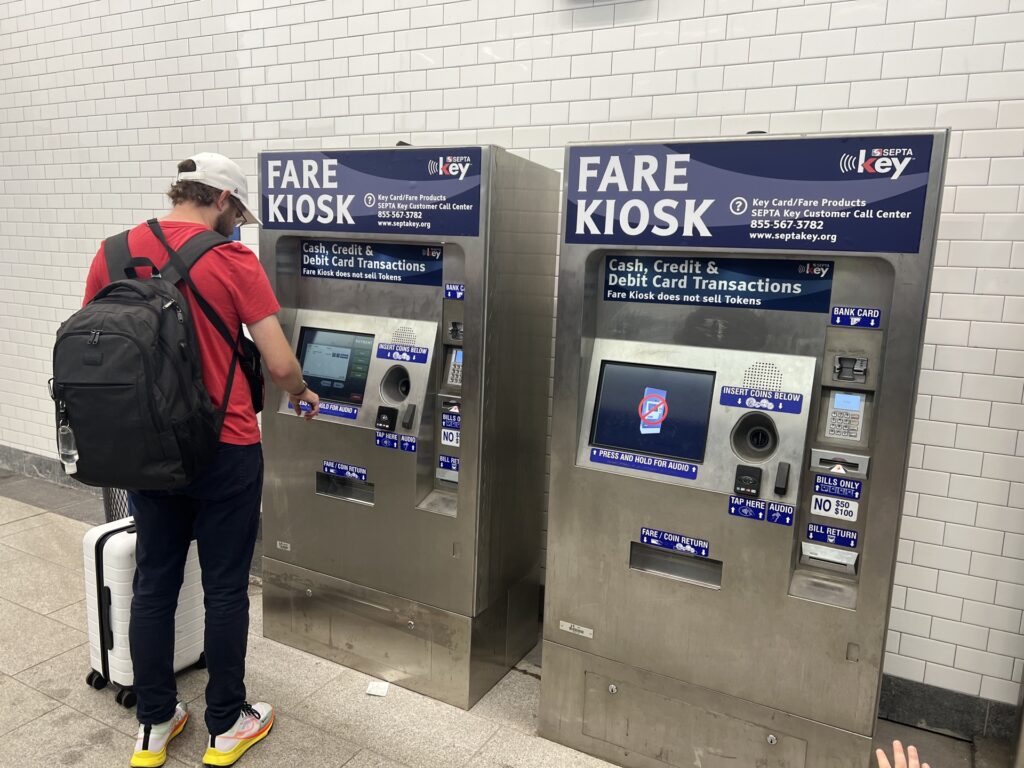
Return train from Philadelphia to NYC
After enjoying a lovely weekend in Philly, it was time to head back to NYC. This time, we took the Keystone Service from Philadelphia to NYC. It’s maybe worth noting that we rescheduled this portion of the trip at the last minute.
Our original return train was on the Northeast Regional, departing at 2:18 PM. At the time we booked, we thought we’d stay for the Fourth of July parade. However, our toddler wasn’t really having it on this trip, and none of us thought that skipping a nap again was a good idea. We decided to change to the 10:30 AM train on the Keystone Service.
Amtrak doesn’t typically offer free changes for the “Saver” fare (the cheapest fare class). However, they began waiving those change fees during the 2020 pandemic, and are continuing to waive them until December 31, 2024. That meant we were able to change to an earlier train and only pay the price difference. Unfortunately, it was a pretty steep difference. The original fare (2 adults, 1 child) was $47.50, and the new fare for the earlier train at a day’s notice was $127.50.
Boarding the Amtrak Train in Philadelphia
We took the SEPTA train from our hotel (near the 2nd Street stop) to the Amtrak station (30th Street stop). Again, we probably would do a rideshare next time. Since we expected to take public transportation this whole time, we didn’t bring our Pico Portable Car Seat, so taking a rideshare this time wasn’t an option.
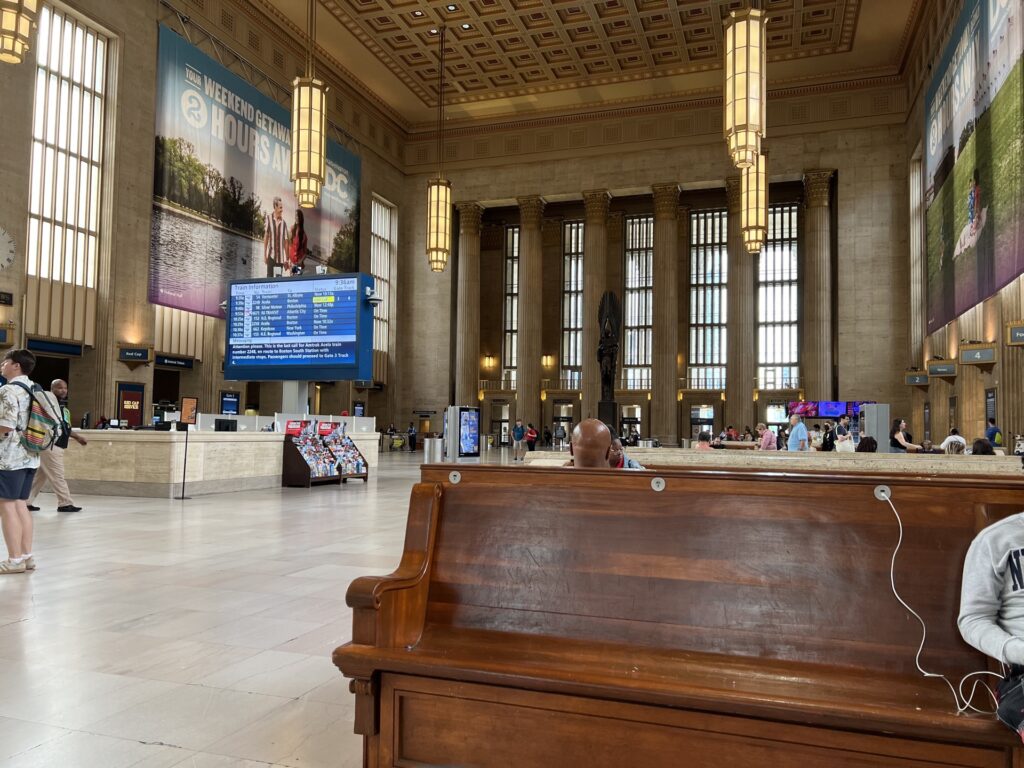
We arrived at the William H. Gray III 30th Street at 9:30 AM. It was earlier than necessarily, but we had no other plans. The Amtrak Station in Philly is quite nice. It’s very spacious, with lots of open seating — plus UBS chargers at every seat. There were several restaurants and shops open, which was fortunate given it was a holiday. There was a large train status board at the center of station, that made it easy to see which trains were boarding where.
Shortly after 10 AM, they announced the track for our train and we got in the queue. A conductor passed by and saw that we were traveling with a young child and grabbed us and another family. He lead us all down to the track level ahead of the line, so we could board the train first. Family boarding on Amtrak is always inconsistent, but it can be a very helpful perk if you get it.
The train pulled up at 10:15 AM. This train doesn’t originate in Philadelphia, so we weren’t sure how crowded the train would be. Fortunately, there were several empty cars on the train that were reserved for Philly passengers.
Since we were the first ones down to the tracks, we were the first ones to board the train. Coach on the Keystone Service train is open seating, just like the Coach section on nearly all Amtrak trains. We could board any open car and select any seat that was available.
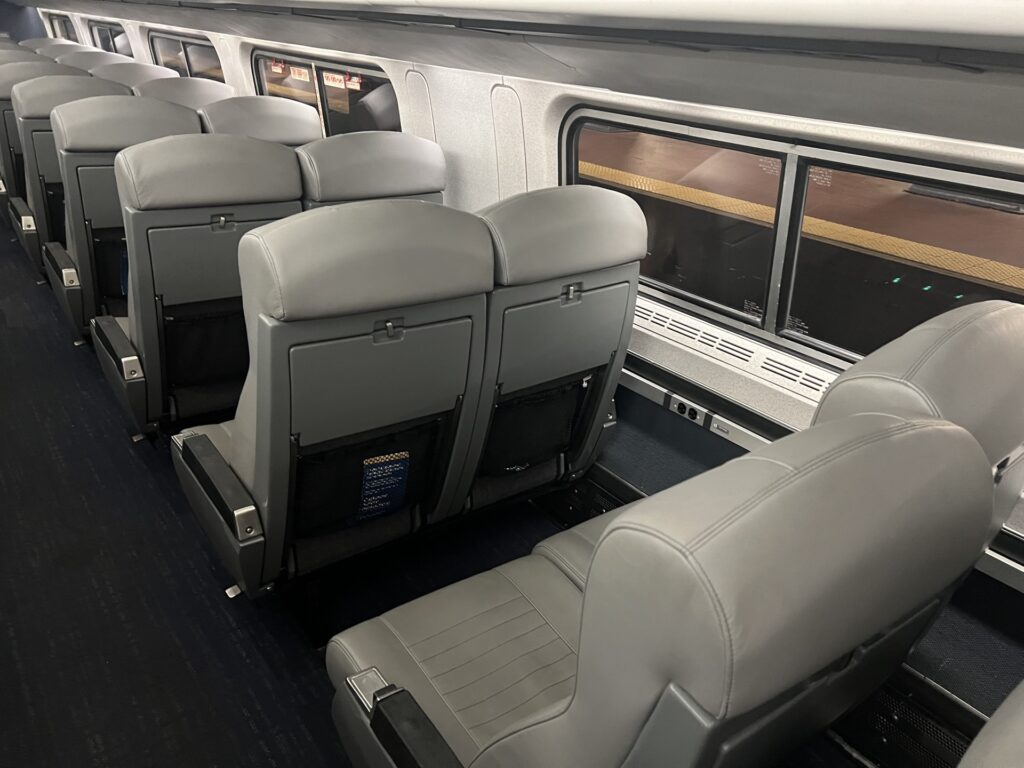
FYI: The Quiet Car on the Keystone service is at the very front of the train. We obviously avoided that one.
Riding the Keystone Service Train from Philadelphia to NYC
The experience riding the Keystone Service from Philadelphia to NYC was very similar to our experience on the Northeast Regional the other direction.
The seats themselves were nearly identical on both trains. They were equally plush and comfortable, with similar width and legroom. There were tray tables at each seat, as well as two outlets on the window side at each row.
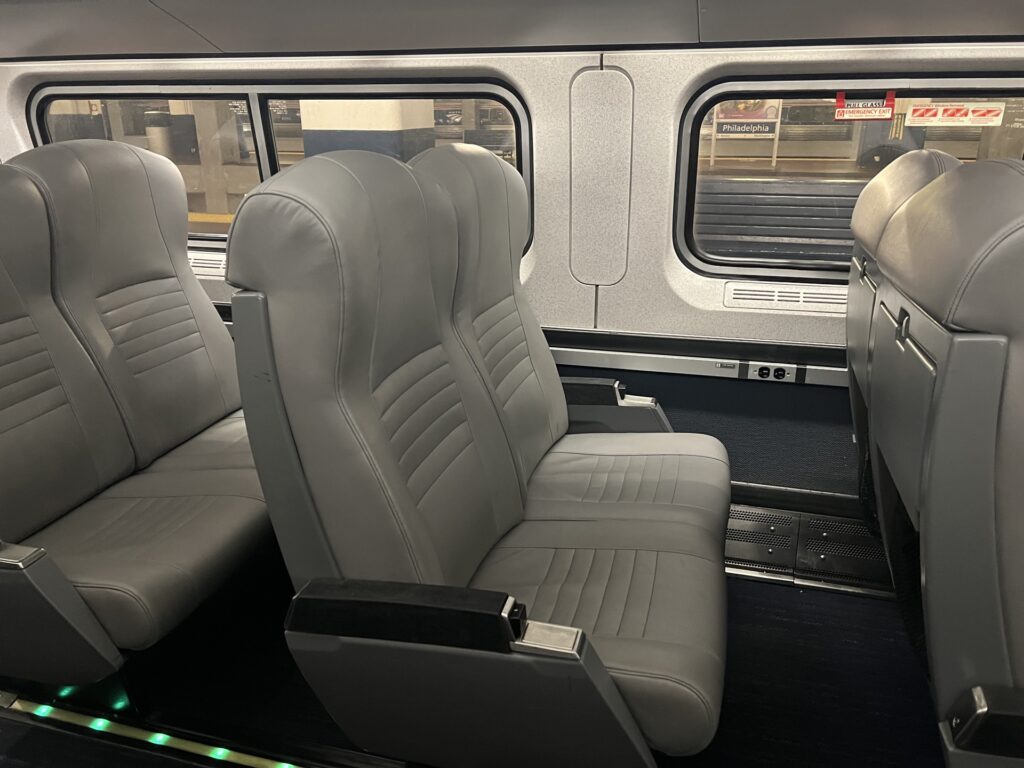
Both trains had free wifi, of roughly equal quality. The baggage policy is also the same on both trains. There was plenty of storage under the seat, above the seat, and in luggage racks at the end of each car. Bathrooms were located in every car.
That said, there were a few differences between the Keystone Service and the Northeast Regional.
On major difference between the two trains used to be seat direction. However, a change to the seating configuration in 2024 on the Northeast Region trains means that now half the seats face forward and half the seats face backward on both trains. (This is so the train can run in either direction without having to reorient the cars or seats.) If you’re prone to motion sickness, sitting backwards can make it worse. If you aren’t sure which direction the train is going, check with a conductor before you pick your seat.

Now, the biggest difference is that there is no cafe car on the Keystone Service. This probably isn’t that big of deal on the Philly to NYC leg — we didn’t visit the cafe car on the Northeast Regional during our short trip the other direction. However, it’s definitely worth noting so you can pack snacks and drinks accordingly.
Lastly, the Keystone Service does not have any premium cars. Keystone Service is all Coach class, while Northeast Regional has Coach and Business Class accommodations.
As far as we were concerned though, these trains were pretty interchangeable. We’d take whichever one was cheaper or fit better into our schedule.
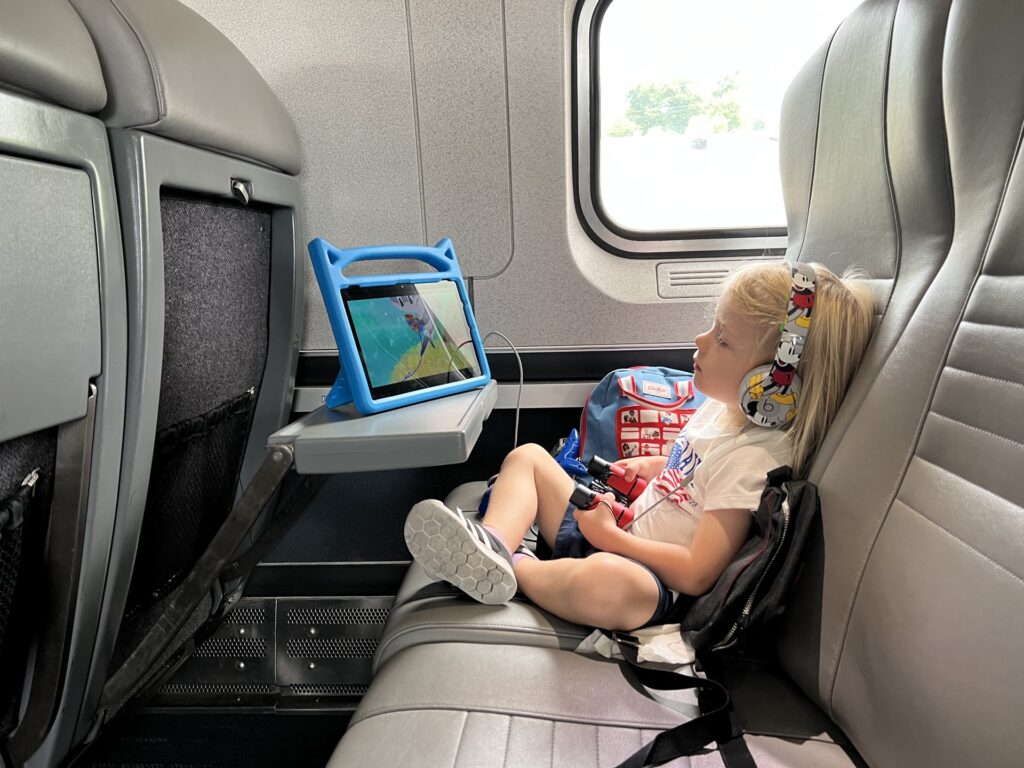
Closing Thoughts
If you’re considering a trip to Philadelphia from NYC, give Amtrak a try. I think you’ll probably find it’s more comfortable than a plane, more relaxing than a car, and usually faster than both. If you’re looking for a high-speed or luxury option, spring for the Acela. Otherwise, the Coach section on most of the other trains that run this route are pretty interchangeable.
Overall, we are big fans of Amtrak. When we lived in Chicago, we frequently traveled on the Lincoln Service between Chicago and Springfield. Since moving to New York City, we rely on Amtrak to get to cities up and down the coast. We don’t have a car and it’s not always reasonable to fly, and Amtrak fills that travel gap perfectly. Not to mention the fact that train travel is substantially more environmentally friendly than either planes or cars.
